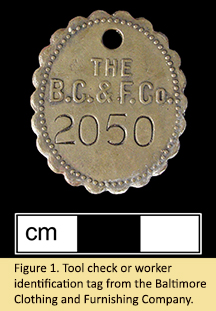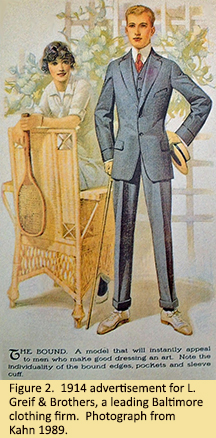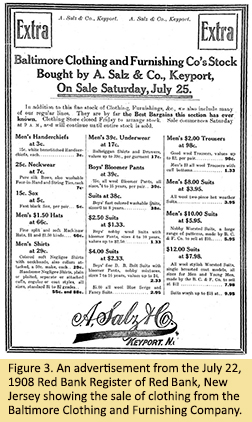Tool Check Tag
June 2014
By Patricia Samford, MAC Lab Director
 Archaeological work done in advance of the Federal Reserve Bank construction in Baltimore in 1980 yielded the usual array of filled privies, wells and cellar holes. But under Barre Street, archaeologists discovered a twenty-foot long section of drainpipe containing thousands of early twentieth-century artifacts concreted into a solid mass filling the bottom half of the pipe (McCarthy and Basalik 1980). A little documentary research revealed that the contents of the pipe were associated with a Chinese-owned commercial laundry located nearby.
Archaeological work done in advance of the Federal Reserve Bank construction in Baltimore in 1980 yielded the usual array of filled privies, wells and cellar holes. But under Barre Street, archaeologists discovered a twenty-foot long section of drainpipe containing thousands of early twentieth-century artifacts concreted into a solid mass filling the bottom half of the pipe (McCarthy and Basalik 1980). A little documentary research revealed that the contents of the pipe were associated with a Chinese-owned commercial laundry located nearby.
In addition to thousands of straight pins, buttons, safety pins, coins, pieces of jewelry and other clothing-related items from the pipe, an oval copper alloy disk stamped “B.C. & F. Co. 2050” was found. This item served as a worker identification tag or as a tool check tag. Tool checks were used by factory workers to requisition tools; each tag bore the worker’s identification number. If the tool had not been returned at the end of the day, the number would be used to track down the missing tool to the employee who had checked it out.
 A New Jersey newspaper advertisement from 1908 revealed that “B. C. & F.” were the initials of The Baltimore Clothing and Furnishing Company (Red Bank Register 1908), a firm that, in accordance with garment trade industry standards, produced men’s suits, trousers, sport coats, and overcoats, as well as men’s pajamas, hosiery, ties, underwear and shirts (Kahn 1989:xiii).
A New Jersey newspaper advertisement from 1908 revealed that “B. C. & F.” were the initials of The Baltimore Clothing and Furnishing Company (Red Bank Register 1908), a firm that, in accordance with garment trade industry standards, produced men’s suits, trousers, sport coats, and overcoats, as well as men’s pajamas, hosiery, ties, underwear and shirts (Kahn 1989:xiii).
 This small item is a very tangible reminder of Baltimore’s prominent position in the nation’s garment industry. The manufacture of clothing was in its Baltimore heyday in the late 19th and early 20th centuries, ranking fourth in the nation in 1900 (Stanger 1999). Large clothing production companies began to replace smaller sweatshops in the early 20th century to satisfy the demand for ready-made clothing. The mechanization and assembly-line nature of these larger operations maximized efficiency and profits, but resulted in a workforce that was less skilled overall (Argersinger 1991:86).
This small item is a very tangible reminder of Baltimore’s prominent position in the nation’s garment industry. The manufacture of clothing was in its Baltimore heyday in the late 19th and early 20th centuries, ranking fourth in the nation in 1900 (Stanger 1999). Large clothing production companies began to replace smaller sweatshops in the early 20th century to satisfy the demand for ready-made clothing. The mechanization and assembly-line nature of these larger operations maximized efficiency and profits, but resulted in a workforce that was less skilled overall (Argersinger 1991:86).
The industry provided jobs for recent immigrants to the city, with well over half of the employed being adult and teenaged females working in low-skill and low wage positions. Skilled positions—cutting, trimming and pressing—were reserved for men. Worker discontent over long hours, deplorable working conditions and low wages sparked a number of strikes, the first of which occurred in 1890 (Kahn 1989:80). Attempts to unionize the workforce were not long in coming and two competing unions, the United Garment Workers (UGW) and the Amalgamated Clothing Workers of America (ACWA), struggled for control in Baltimore’s men’s clothing industry during the early twentieth century (Argersinger 1991:90).
| References |
|
| Argersinger, Jo Ann E. |
| 1991 |
The City that Tries to Suit Everybody: Baltimore’s Clothing Industry. In The Baltimore Book; New Views of Local History. Edited by Elizabeth Fee, Linda Shopes and Linda Zeidman. Temple University Press, Philadelphia, pp. 80-101. |
|
| Kahn, Philip, Jr. |
| 1989 |
A Stitch in Time; The Four Seasons of Baltimore’s Needle Trades. Maryland Historical Society, Baltimore, Maryland. |
|
| McCarthy, John P. and Kenneth J. Basalik |
| 1980 |
Summary Report of Archaeological Investigations Federal Reserve Bank Site, Baltimore, Maryland. Report prepared for the Maryland Historical Trust by Mid-Atlantic Archaeological Research, Inc., Newark, Delaware. |
|
| Red Bank Register |
| 1908 |
Advertisement for A. Salz & Co. Red Bank Register, Red Bank, New Jersey. Volume XXXI, No. 5, p. 11 (July 22, 1908). |
|
| Stanger, Howard R. |
| 1999 |
Review of Making Amalgamated: Gender, Ethnicity and Class in the Baltimore Clothing Industry, 1899-1939. Jo Ann Argersinger. Johns Hopkins University Press, Baltimore. Reviewed on EH.Net in November 1999. Website www.h-net.org/reviews/showrev.php?id=3567 accessed October 30, 2013. |
|